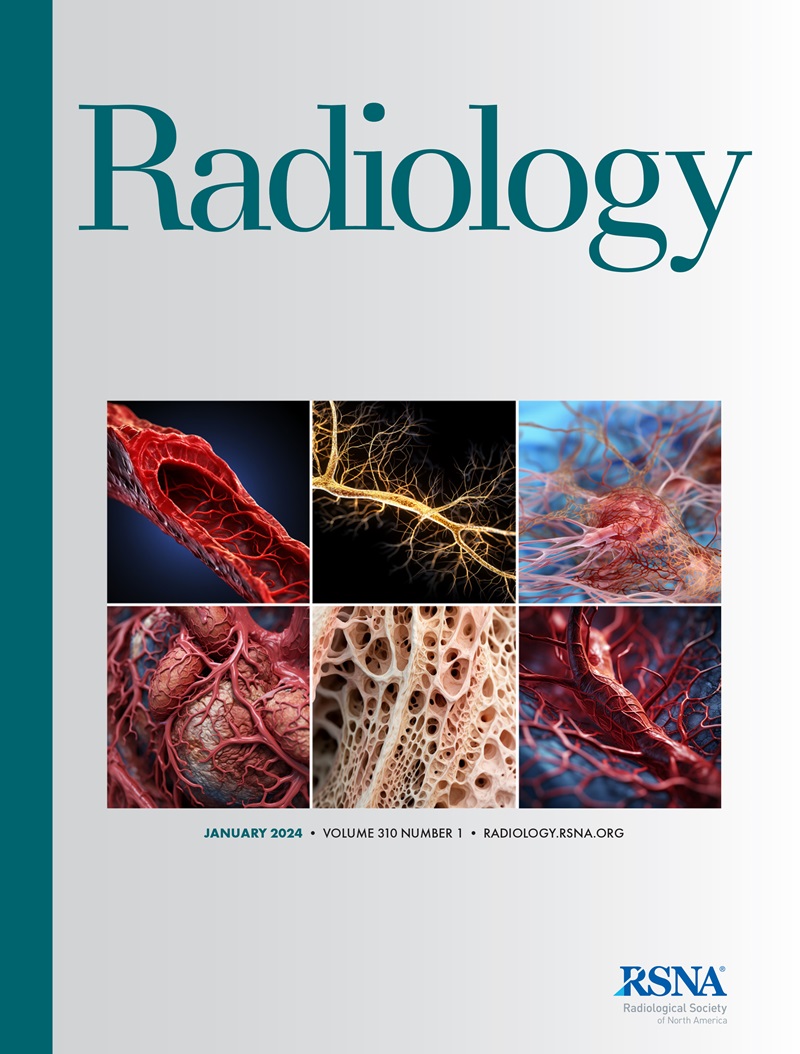Toulsie Ramtohul, Derek Lollivier, Justine Spriet, Maxime Jin, Lounes Djerroudi, Thomas Gaillard, Claire Bonneau, Delphine Loirat, Diana Bello-Roufai, Youlia Kirova, Pierre Loap, Caroline Malhaire, Anne Vincent Salomon, François-Clément Bidard, Anne Tardivon, Audrey Maillez, Lauren Wallaert, Luc Ceugnart, Caroline Nhy, Luc Cabel
求助PDF
{"title":"治疗后MRI预测三阴性乳腺癌对新辅助化疗免疫治疗的病理完全反应。","authors":"Toulsie Ramtohul, Derek Lollivier, Justine Spriet, Maxime Jin, Lounes Djerroudi, Thomas Gaillard, Claire Bonneau, Delphine Loirat, Diana Bello-Roufai, Youlia Kirova, Pierre Loap, Caroline Malhaire, Anne Vincent Salomon, François-Clément Bidard, Anne Tardivon, Audrey Maillez, Lauren Wallaert, Luc Ceugnart, Caroline Nhy, Luc Cabel","doi":"10.1148/radiol.243824","DOIUrl":null,"url":null,"abstract":"<p><p>Background Neoadjuvant chemoimmunotherapy (NACI) has substantially improved pathologic complete response (pCR) rates in early triple-negative breast cancer (TNBC). However, the predictive accuracy of posttreatment MRI remains unexplored. Purpose To assess the performance of posttreatment MRI in the prediction of pCR in participants with TNBC treated with NACI. Materials and Methods In this prospective multicenter study (August 2021-June 2024), women with early TNBC were recruited from three centers (training set: Institut Curie; test set: Institut Godinot and Institut Oscar Lambret). Post-NACI dynamic contrast-enhanced MRI scans from multiple vendors were analyzed. Radiologic complete response (rCR)-defined as no enhancement in the tumor bed-was evaluated for predicting pCR. A multivariable logistic regression model incorporating rCR, nodal involvement, and Ki-67 index was developed and externally validated. In cases with residual enhancement (non-rCR), a radiomic score using shape and first-order features was tested. Results A total of 175 women were included in the training set (mean age, 49 years ± 11 [SD]) and 84 women in the external test set (mean age, 52 years ± 12). The rCR at MRI was predictive of pCR, with an area under the receiver operating characteristic curve (AUC) of 0.83 (95% CI: 0.75, 0.92). The combined model (rCR + nodal status + Ki-67) yielded an AUC of 0.88 (95% CI: 0.81, 0.96) in the test set. In node-negative patients with Ki-67 greater than 30%, the rCR false-discovery rate (ie, the proportion of rCR cases that were actually non-pCR or residual disease missed at breast MRI) was 3.6% (two of 56) in the training set and 3.5% (one of 29) in the test set; all cancers were limited to residual cancer burden I. In non-rCR cases, a model incorporating the radiomics score and lesion count achieved an AUC of 0.80 (95% CI: 0.69, 0.90). Conclusion Posttreatment rCR at MRI demonstrated strong predictive value for pCR in early TNBC following NACI. © RSNA, 2025 <i>Supplemental material is available for this article.</i> See also the editorial by Onishi in this issue.</p>","PeriodicalId":20896,"journal":{"name":"Radiology","volume":"316 1","pages":"e243824"},"PeriodicalIF":15.2000,"publicationDate":"2025-07-01","publicationTypes":"Journal Article","fieldsOfStudy":null,"isOpenAccess":false,"openAccessPdf":"","citationCount":"0","resultStr":"{\"title\":\"Posttreatment MRI to Predict Pathologic Complete Response of Triple-Negative Breast Cancer to Neoadjuvant Chemoimmunotherapy.\",\"authors\":\"Toulsie Ramtohul, Derek Lollivier, Justine Spriet, Maxime Jin, Lounes Djerroudi, Thomas Gaillard, Claire Bonneau, Delphine Loirat, Diana Bello-Roufai, Youlia Kirova, Pierre Loap, Caroline Malhaire, Anne Vincent Salomon, François-Clément Bidard, Anne Tardivon, Audrey Maillez, Lauren Wallaert, Luc Ceugnart, Caroline Nhy, Luc Cabel\",\"doi\":\"10.1148/radiol.243824\",\"DOIUrl\":null,\"url\":null,\"abstract\":\"<p><p>Background Neoadjuvant chemoimmunotherapy (NACI) has substantially improved pathologic complete response (pCR) rates in early triple-negative breast cancer (TNBC). However, the predictive accuracy of posttreatment MRI remains unexplored. Purpose To assess the performance of posttreatment MRI in the prediction of pCR in participants with TNBC treated with NACI. Materials and Methods In this prospective multicenter study (August 2021-June 2024), women with early TNBC were recruited from three centers (training set: Institut Curie; test set: Institut Godinot and Institut Oscar Lambret). Post-NACI dynamic contrast-enhanced MRI scans from multiple vendors were analyzed. Radiologic complete response (rCR)-defined as no enhancement in the tumor bed-was evaluated for predicting pCR. A multivariable logistic regression model incorporating rCR, nodal involvement, and Ki-67 index was developed and externally validated. In cases with residual enhancement (non-rCR), a radiomic score using shape and first-order features was tested. Results A total of 175 women were included in the training set (mean age, 49 years ± 11 [SD]) and 84 women in the external test set (mean age, 52 years ± 12). The rCR at MRI was predictive of pCR, with an area under the receiver operating characteristic curve (AUC) of 0.83 (95% CI: 0.75, 0.92). The combined model (rCR + nodal status + Ki-67) yielded an AUC of 0.88 (95% CI: 0.81, 0.96) in the test set. In node-negative patients with Ki-67 greater than 30%, the rCR false-discovery rate (ie, the proportion of rCR cases that were actually non-pCR or residual disease missed at breast MRI) was 3.6% (two of 56) in the training set and 3.5% (one of 29) in the test set; all cancers were limited to residual cancer burden I. In non-rCR cases, a model incorporating the radiomics score and lesion count achieved an AUC of 0.80 (95% CI: 0.69, 0.90). Conclusion Posttreatment rCR at MRI demonstrated strong predictive value for pCR in early TNBC following NACI. © RSNA, 2025 <i>Supplemental material is available for this article.</i> See also the editorial by Onishi in this issue.</p>\",\"PeriodicalId\":20896,\"journal\":{\"name\":\"Radiology\",\"volume\":\"316 1\",\"pages\":\"e243824\"},\"PeriodicalIF\":15.2000,\"publicationDate\":\"2025-07-01\",\"publicationTypes\":\"Journal Article\",\"fieldsOfStudy\":null,\"isOpenAccess\":false,\"openAccessPdf\":\"\",\"citationCount\":\"0\",\"resultStr\":null,\"platform\":\"Semanticscholar\",\"paperid\":null,\"PeriodicalName\":\"Radiology\",\"FirstCategoryId\":\"3\",\"ListUrlMain\":\"https://doi.org/10.1148/radiol.243824\",\"RegionNum\":1,\"RegionCategory\":\"医学\",\"ArticlePicture\":[],\"TitleCN\":null,\"AbstractTextCN\":null,\"PMCID\":null,\"EPubDate\":\"\",\"PubModel\":\"\",\"JCR\":\"Q1\",\"JCRName\":\"RADIOLOGY, NUCLEAR MEDICINE & MEDICAL IMAGING\",\"Score\":null,\"Total\":0}","platform":"Semanticscholar","paperid":null,"PeriodicalName":"Radiology","FirstCategoryId":"3","ListUrlMain":"https://doi.org/10.1148/radiol.243824","RegionNum":1,"RegionCategory":"医学","ArticlePicture":[],"TitleCN":null,"AbstractTextCN":null,"PMCID":null,"EPubDate":"","PubModel":"","JCR":"Q1","JCRName":"RADIOLOGY, NUCLEAR MEDICINE & MEDICAL IMAGING","Score":null,"Total":0}
引用次数: 0
引用
批量引用

 求助内容:
求助内容: 应助结果提醒方式:
应助结果提醒方式:


